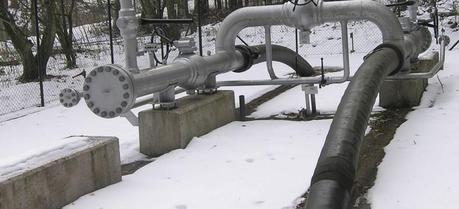 A station on a natural gas pipeline used for the loading and unloading of pipeline inspection gauges, commonly known as "pigs". (Credit: Audrius Meskauskas http://commons.wikimedia.org/wiki/User:Audriusa)
A station on a natural gas pipeline used for the loading and unloading of pipeline inspection gauges, commonly known as "pigs". (Credit: Audrius Meskauskas http://commons.wikimedia.org/wiki/User:Audriusa)
“Power to gas” is one of the key concepts in renewable energy storage. The idea is to convert short-term excess electricity from solar panels and wind turbines into hydrogen. Combined with the CO2, renewable hydrogen can be used to produce methane, which can then be stored and distributed in the natural gas network. Scientists at the Swiss Federal Laboratories for Materials Science and Technology (Empa) in Zurich, Switzerland, have now succeeded in further optimizing this process.
The Sabatier reaction or Sabatier process involves the reaction of hydrogen with carbon dioxide at elevated temperatures (optimal 300-400 °C) and pressures in the presence of a nickel catalyst to produce methane and water. It has been proposed in a renewable energy dominated energy system to use the excess electricity generated by wind, solar photovoltaic, hydro, marine current, etc. to make methane (natural gas).
The Sabatier process, which produces combustible methane from hydrogen and CO2, hwas discovered by the French chemist Paul Sabatier in the 1910s. Now researchers in the Empa “Hydrogen and Energy” Department have succeeded in greatly optimizing the process.
As described above, a catalyst (most commonly nickel) is required to bring about the reaction of CO2 with hydrogen using as little energy as possible. The gas molecules react more easily with each other on the surface of such a catalyst, reducing the energy required for the reaction to take place. This is referred to as sorption catalysis. Empa researcher, Andreas Borgschulte, and his team have now combined a nanoscale nickel catalyst with a zeolite. Zeolites are crystalline aluminosilicates with the ability to absorb water molecules and release them again when heated.
The principle is simple: the chemical reaction of hydrogen with CO2 produces not only methane (CH4), but also water (H2O). The researchers use the hygroscopic (i.e. water-binding) property of the zeolite to remove the resulting water from the reaction mixture. The chemical equilibrium then moves towards methane. Result: a higher yield of pure methane and a more efficient catalytic process. As soon as the zeolite is saturated with water, it can be “unloaded” again by heating and evaporation of the water, and is then re-used.
The process works—though currently only in the laboratory. According to Borgschulte, there is still a long way to go before it is ready for commercialization. Empa researchers are currently looking for project partners in order to build a methanation plant on a larger scale and use it as a pilot project.
At the same time, Borgschulte’s team would like to optimize the process even further. The next stage is to use four or more sorption catalysts at the same time. When one is saturated with water, the system automatically jumps to the next “dry” catalyst while the previous one is being “unloaded” again.
One problem with this cyclical method up to now has been sulphur, which is produced in biogas plants together with methane and CO2. Sulphur compounds can cause irreparable damage to the zeolite. The researchers are now working on removing the sulfur from crude biogas so that the zeolite continues to work for as long as possible.
In future, Borgschulte also thinks it is conceivable that new catalyst materials that are more efficient than nickel may be used in combination with the zeolite. These could improve the Sabatier process even further. This would mean that excess renewable electricity was no longer wasted but used as the basis for producing sustainable natural gas.
Borgschulte A., Gallandat N., Probst B., Suter R., Callini E., Ferri D., Arroyo Y., Erni R., Geerlings H., & Züttel A. (2013). Sorption enhanced CO2 methanation. Physical Chemistry Chemical Physics (PCCP), 15 (24), 9620-5 PMID: 23673365
